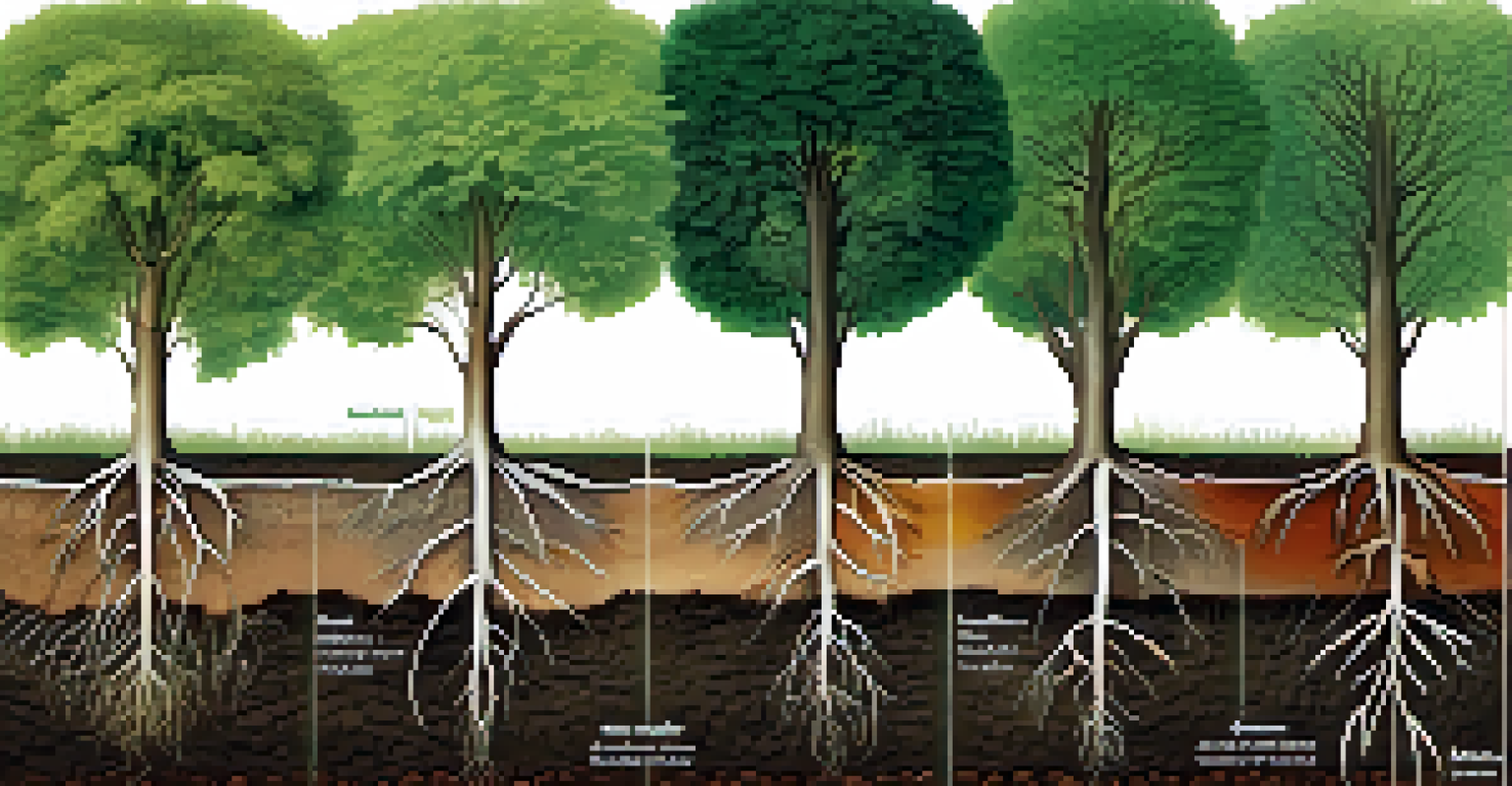The Role of Roots in Soil Stability and Erosion Control

The Importance of Soil Stability for Ecosystems
Soil stability is vital for maintaining healthy ecosystems, playing a crucial role in supporting plant life. When soil is stable, it can retain moisture, nutrients, and support the growth of diverse flora and fauna. However, unstable soil can lead to a host of problems, including erosion, decreased fertility, and habitat loss. Understanding the factors that contribute to soil stability helps us appreciate the intricate balance of our environment.
The soil is the great connector of our lives, the source and destination of all. Food, fiber, and biodiversity are all dependent on our soil and its health.
Roots are one of the key factors in ensuring soil stability, acting like natural anchors that hold the earth together. Their intricate network weaves through the soil, creating a strong structure that resists displacement. This anchoring effect not only supports plants but also enhances the soil's overall integrity. Without roots, soil is much more susceptible to the forces of nature, such as wind and water erosion.
In essence, healthy root systems contribute to a stable foundation for ecosystems, allowing them to flourish. By maintaining soil stability, roots play a pivotal role in promoting biodiversity and supporting the food web. Thus, understanding the significance of roots in soil stability is essential for effective environmental conservation efforts.
How Roots Prevent Soil Erosion
Soil erosion occurs when soil particles are detached and removed from their original location, often due to water or wind. This process can be exacerbated by human activities, such as deforestation or poor agricultural practices. Roots help mitigate erosion by binding soil particles together, creating a cohesive structure that resists these erosive forces. Their presence stabilizes the soil and prevents the loss of fertile topsoil, which is crucial for agriculture.

Different types of plants contribute to erosion control in various ways. For instance, deep-rooted plants, like trees, provide strong anchors that can withstand heavy rains and wind. Meanwhile, shallow-rooted plants, such as grasses, create a dense mat that protects the soil surface from raindrop impact and surface runoff. Together, these diverse root systems play a multifaceted role in preventing soil erosion.
Roots Anchor Soil and Prevent Erosion
Roots play a critical role in stabilizing soil by binding particles together and reducing the risk of erosion from wind and water.
Moreover, the organic matter that roots contribute to the soil enhances its structure and fertility. As roots grow and decay, they add nutrients and improve the soil's ability to retain moisture, making it more resilient against erosion. In this way, roots not only prevent soil erosion but also create a healthier environment for plants to thrive.
The Role of Root Depth in Soil Stability
Root depth is a significant factor in how effectively plants can stabilize soil. Deep-rooted plants can reach moisture and nutrients buried deeper in the soil, while also providing stronger anchorage. This depth allows them to withstand more severe weather conditions, such as heavy rains or high winds, which might otherwise dislodge shallower-rooted plants. As a result, deep-rooted species are often more effective at preventing erosion in vulnerable areas.
Healthy soil is the foundation of a healthy ecosystem, and the health of our soil impacts everything from our food to our water supply.
Conversely, shallow-rooted plants can also play an essential role, particularly in preventing surface erosion. Their widespread and dense root networks create a protective barrier that reduces the impact of raindrops on the soil surface. This surface stability is crucial during periods of heavy rainfall when erosion risks are at their highest.
In ecosystems facing erosion challenges, a balance of deep and shallow roots can provide optimal soil stability. By promoting a diverse array of plant species, land managers can encourage a robust root system that addresses both deep and surface erosion concerns. This multifaceted approach to root depth can significantly enhance soil stability and protect against erosion.
Root Exudates and Soil Health
Roots do more than just anchor plants; they also release organic compounds known as root exudates. These substances play a vital role in soil health by promoting beneficial microbial activity. When roots exude these compounds, they create a conducive environment for microorganisms, which help decompose organic matter and recycle nutrients. This interaction between roots and microbes is essential for maintaining soil fertility.
Moreover, root exudates can enhance soil structure by encouraging the formation of soil aggregates. These aggregates improve water infiltration and aeration, making the soil more resilient to erosion. By fostering a thriving community of soil organisms, roots indirectly contribute to a more stable and productive ecosystem.
Native Plants Enhance Soil Stability
Incorporating native plants with deep root systems into landscapes promotes better soil health and erosion control due to their adaptability to local conditions.
In summary, the relationship between roots and soil health is symbiotic, with exudates playing a crucial role in sustaining soil stability. By understanding this dynamic, we can better appreciate the interconnectedness of plant life and soil health. This knowledge underscores the importance of preserving plant diversity to ensure the vitality of our ecosystems.
Impact of Land Use on Root Systems
Human activities, such as urbanization and agriculture, significantly affect root systems and their ability to stabilize soil. For instance, land development often leads to soil compaction, which restricts root growth and diminishes their anchoring capabilities. Without sufficient root systems, soil becomes more vulnerable to erosion, leading to a cascade of negative environmental impacts.
Agricultural practices can also influence root health. Monoculture farming, where a single crop is planted over large areas, often results in shallow root systems that are less effective at preventing soil erosion. In contrast, diversifying crops can promote a variety of root depths and structures, enhancing soil stability and reducing erosion risks.
To combat these challenges, sustainable land management practices are essential. Techniques like crop rotation, cover cropping, and reduced tillage can help foster healthy root systems that stabilize soil. By prioritizing land use practices that support root growth, we can protect our soil resources and mitigate erosion.
The Role of Native Plants in Erosion Control
Native plants are often better suited for soil stabilization than non-native species due to their deep and extensive root systems. These plants have evolved to thrive in local conditions, making them more resilient to environmental stressors. Their roots are adept at binding soil particles together, which helps protect against erosion and promotes soil health.
Incorporating native plants into landscaping and restoration projects can significantly enhance soil stability. By choosing native species, we can create a robust ecosystem that supports local wildlife while effectively controlling erosion. Additionally, native plants require less maintenance and are generally more drought-resistant, making them an ideal choice for sustainable landscaping.
Root Depth Matters for Ecosystems
The depth of plant roots significantly influences their ability to stabilize soil, with a mix of deep and shallow roots providing optimal protection against erosion.
Ultimately, embracing native plants in erosion control efforts can yield long-lasting benefits. By prioritizing local flora, we can not only stabilize soil but also foster biodiversity and resilience in our ecosystems. This approach highlights the importance of working with nature to achieve effective erosion control.
The Future of Roots in Soil Conservation Efforts
As we face increasing environmental challenges, the role of roots in soil conservation becomes even more critical. Innovative approaches to land management and restoration are emerging, focusing on enhancing root systems to improve soil stability. By prioritizing the health of root systems, we can address erosion issues and promote sustainable land use.
Research into root biology and ecology is providing valuable insights into how we can leverage root systems for better soil management. Understanding the specific needs of different plant species can help us design effective planting schemes that enhance soil stability. This scientific approach, combined with traditional knowledge, can lead to more effective erosion control strategies.

In conclusion, the future of roots in soil conservation efforts is bright. By recognizing the essential role roots play in maintaining soil stability and preventing erosion, we can develop more effective strategies for protecting our environment. Investing in root health and diversity will be key to achieving sustainable landscapes for generations to come.